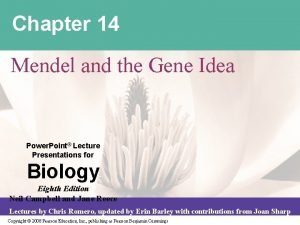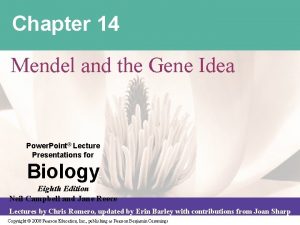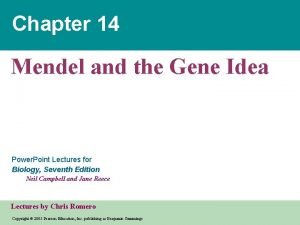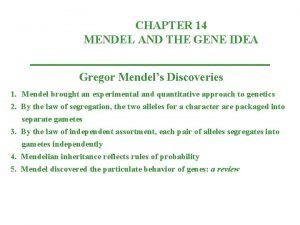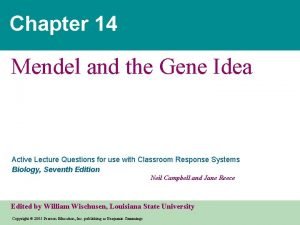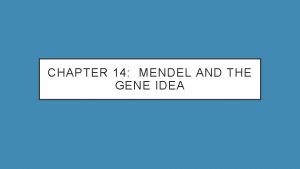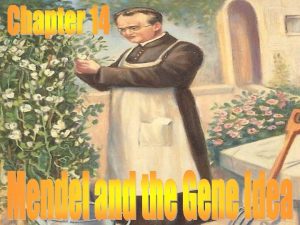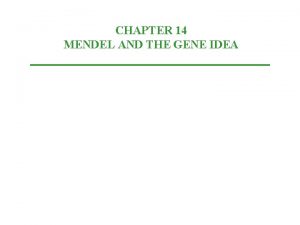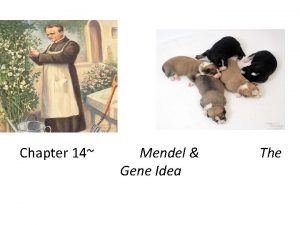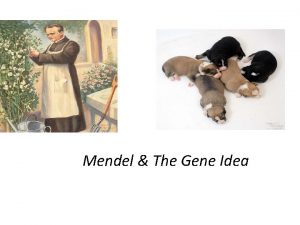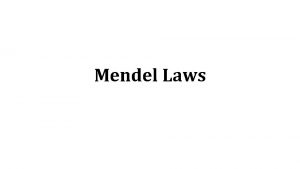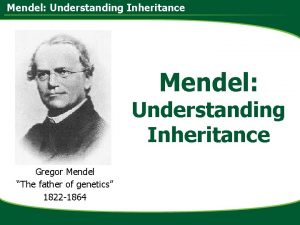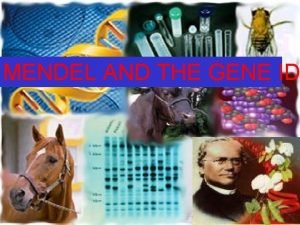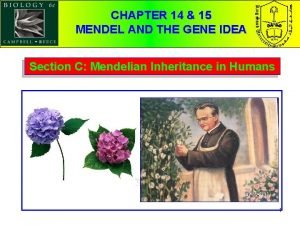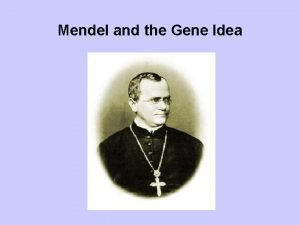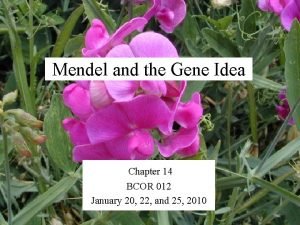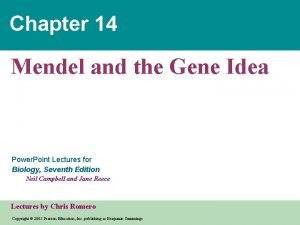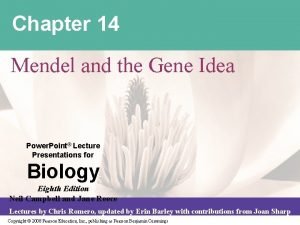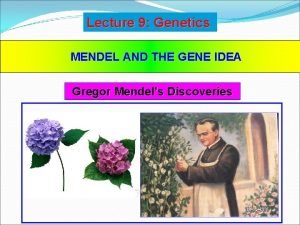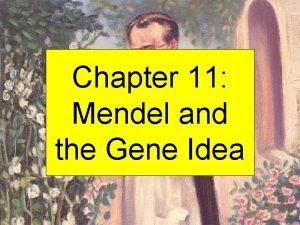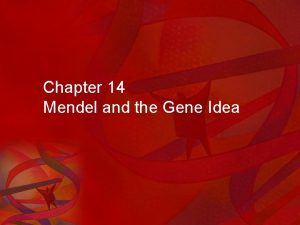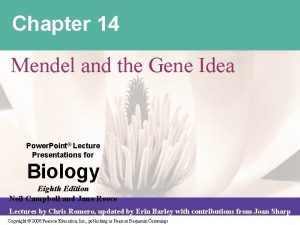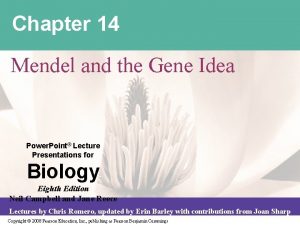Mendel and the Gene Idea Mendel and the

























- Slides: 25

Mendel and the Gene Idea

Mendel and the Gene Idea 4 Mendel’s law of independent assortment: – Each allele pair segregates independently of other gene pairs during gamete formation.

Mendel and the Gene Idea 4 Rule of Multiplication: – The probability that an independent events will occur simultaneously is the product of their individual probabilities!

Mendel and the Gene Idea 4 What is the probability that a trihybrid cross between two organisms with genotypes Aa. Bb. Cc and Aa. Bb. Cc will produce an offspring with a genotype aabbcc? 4 Aa x Aa : probability of aa = 1/4 4 Bb x Bb : probability of bb = 1/4 4 Cc x Cc : probability of cc = 1/4 4 Therefore 1/4 x 1/4 = 1/64

Mendel and the Gene Idea 4 Rule of Addition: – The probability of an event that can occur in two or more independent ways is the sum of the separate probabilities of the different ways

Mendel and the Gene Idea 4 What fraction of the offspring from the following cross of garden peas, would show recessive phenotypes for at least two of the three traits? Pp. Yy. Rr x Ppyyrr – ppyy. Rr – pp. Yyrr – Ppyyrr – PPyyrr – ppyyrr – 1/4 x 1/2 = 1/16 1/2 x 1/2 = 2/16 (1/8) 1/4 x 1/2 = 1/16 6/16 or 3/8

Mendel and the Gene Idea 4 Test Cross: The breeding of an organism with an unknown genotype with a homozygous recessive.

Mendel and the Gene Idea

Mendel and the Gene Idea 4 Incomplete dominance: – Pattern of inheritance in which the dominate phenotype is not fully expressed in the heterozygote, resulting in a phenotype intermediate between the homozygote dominate and recessive characteristics. – Blends

Mendel and the Gene Idea 4 Codominance: – Inheritance characterized by full expression of both alleles in the heterozygote. • Blood type • AA (IAIA) • BB(IBIB) • AB(IAIB) Calico cats

Mendel and the Gene Idea 4 Multiple Alleles – some genes may have multiple alleles; that is, more than just two alternative forms of a gene. – These multiple alleles occupy a single locus – Blood typing A, B, and O – IA IB and i

Multiple Alleles

Mendel and the Gene Idea 4 Human disorders – Recessive alleles that cause human disorders are usually defective versions of normal alleles. – Recessively inherited disorders range from nonlethal traits (albinism) to lethal diseases (cystic fibrosis)

Mendel and the Gene Idea 4 Cystic fibrosis: most common lethal genetic disease in the US among Caucasians – Frequency 1 in 2500 – 4% of the Caucasians are carriers – The dominate allele codes for a membrane protein that controls chloride traffic across the cell membrane. -absent in homozygous recessive – Disease symptoms result from the accumulation of thickened mucus in the lungs and pancreas.

Mendel and the Gene Idea 4 Tay-Sachs disease: Incidence is about 100 x higher in central European Jews than among Mediterranean Jews – Frequency 1 in 3600 – Brain cells of babies are unable to metabolize gangliosides - lipid – As lipids increase in the brain, the infant suffers seizures, blindness, and degeneration of motor skills and mental performance. – Child dies after a few years

Mendel and the Gene Idea 4 Pleiotropy: – The ability of a single gene to have multiple phenotypic effects. – There are many hereditary diseases in which a single defective gene causes complex sets of symptoms Sickle-cell Anemia

Mendel and the Gene Idea 4 Sickle-cell disease: most common in African Americans 1 in 400. – Single amino acid substitution in hemoglobin – Abnormal hemoglobin molecules tend to link together and crystallize when blood O 2 is lower than normal – Causes the erythrocyte to form a sickle shape – Sickle cells clog small vessels causing pain, discomfort and fever.

Mendel and the Gene Idea 4 Sickle Cell – 1 in 10 African Americans are carriers – Codominance - carriers may experience discomfort during periods of low blood Ox levels - other wise function normally – Believed to be result of malaria infestation in tropical regions

Mendel and the Gene Idea 4 Sickle cell: – The probability of inheriting the same rare harmful allele from both parents, is greater if the parents are closely related.

Mendel and the Gene Idea 4 Huntington’s disease – Lethal dominate (late acting) – a degenerative disease of the nervous system – does not show until age 35 -40 – irreversible to death – found at the tip of chromosome #4

Mendel and the Gene Idea 4 PKU (phenylketonuria): – recessive 1 in 15, 000 – patient cannot break down the amino acid phenylalanine – build up to toxic levels causes mental retardation – tx with a special diet to avoid toxic levels

Chi Square 4 X 2 = Σ (O-E)2 4 E 4 The null hypothesis in this experiment is to validate the use of the prediction! 4 The alternate hypothesis in this experiment is to discredit the use of the prediction!

Chi Square 4 Degree of freedom: number of possible phenotypic categories minus one.

Chi Square 4 Evaluate the calculated value with the chart! 4 If your calculated value is less than the chart value -- then you fail to reject the null!

Chi Square 4 Last, evaluate your p= value 4 If you fail to reject your null, then this value identifies the percent chance that any difference in your results is due to random chance!
 Mendel and the gene idea chapter 14
Mendel and the gene idea chapter 14 Chapter 14 mendel and the gene idea
Chapter 14 mendel and the gene idea Chapter 14 mendel and the gene idea
Chapter 14 mendel and the gene idea Chapter 14: mendel and the gene idea
Chapter 14: mendel and the gene idea Chapter 14 mendel and the gene idea
Chapter 14 mendel and the gene idea Chapter 14 mendel and the gene idea
Chapter 14 mendel and the gene idea Gene by gene test results
Gene by gene test results Chapter 17 from gene to protein
Chapter 17 from gene to protein Define central idea
Define central idea Controlling idea adalah
Controlling idea adalah Is the main idea the theme
Is the main idea the theme Irrelevant
Irrelevant Whats a supporting idea
Whats a supporting idea Homiletical idea
Homiletical idea Contoh penanda idea
Contoh penanda idea Hát kết hợp bộ gõ cơ thể
Hát kết hợp bộ gõ cơ thể Slidetodoc
Slidetodoc Bổ thể
Bổ thể Tỉ lệ cơ thể trẻ em
Tỉ lệ cơ thể trẻ em Voi kéo gỗ như thế nào
Voi kéo gỗ như thế nào Tư thế worm breton
Tư thế worm breton Hát lên người ơi alleluia
Hát lên người ơi alleluia Các môn thể thao bắt đầu bằng tiếng nhảy
Các môn thể thao bắt đầu bằng tiếng nhảy Thế nào là hệ số cao nhất
Thế nào là hệ số cao nhất Các châu lục và đại dương trên thế giới
Các châu lục và đại dương trên thế giới Công thức tiính động năng
Công thức tiính động năng
